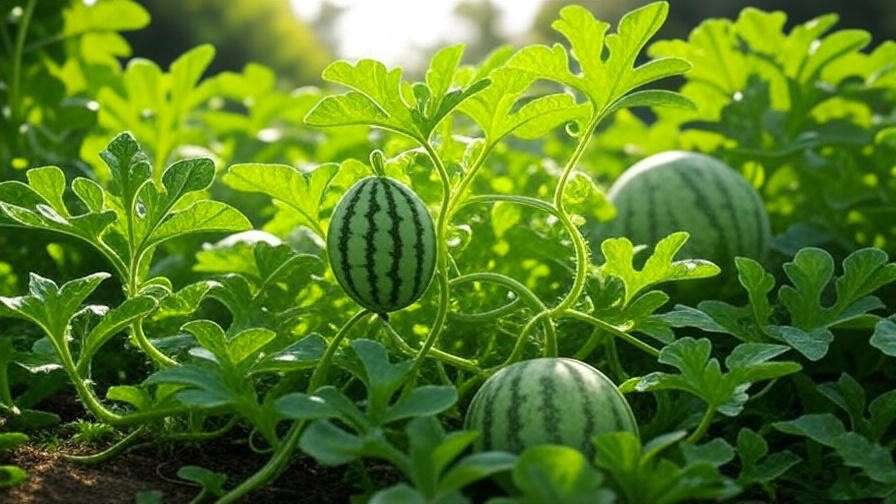Picture this: slicing into a juicy, vibrant Congo watermelon plant’s fruit, grown right in your backyard, bursting with sweet flavor! 🌞 If you’re eager to cultivate this heirloom variety known for its large, delicious fruits, you’ve landed on the perfect guide. As a certified horticulturist with over a decade of experience in tropical fruit cultivation, I’ve crafted this comprehensive guide to help you grow a thriving Congo watermelon plant, from seed to harvest. Whether you’re a beginner or a seasoned gardener, this article addresses common challenges and provides expert-backed solutions for abundant yields. We’ll cover soil preparation, planting techniques, watering, pest control, and harvesting tips to ensure your garden flourishes. Let’s dig in! 🌿
1. Understanding the Congo Watermelon Plant 🌿
1.1 What Is a Congo Watermelon Plant?
The Congo watermelon (Citrullus lanatus ‘Congo’) is a beloved heirloom variety, celebrated for its large, oblong fruits that can weigh 25–40 pounds. Its crisp, sweet flesh and dark green rind with light stripes make it a standout in any garden. This variety thrives in warm climates and is known for its high yields and resistance to some common diseases, making it a favorite among home gardeners. Unlike hybrid watermelons, the Congo retains its rich flavor and robust growth, offering a rewarding experience for those who master its care.
1.2 Ideal Growing Conditions for Congo Watermelons
To grow a thriving Congo watermelon plant, you need to mimic its preferred environment:
- Climate: Congo watermelons love warmth, requiring temperatures between 70–90°F. They need a long growing season (80–90 days) to produce mature fruits.
- Sunlight: Full sun exposure for at least 6–8 hours daily is non-negotiable for healthy vine growth and fruit development.
- Soil: These plants thrive in well-draining, fertile soil with a pH of 6.0–6.8. Sandy loam enriched with organic matter is ideal.
- Expert Tip: Test your soil’s pH using a home testing kit (available at garden centers) to ensure optimal conditions. Adjust with lime to raise pH or sulfur to lower it, if needed.
2. Preparing to Grow Your Congo Watermelon Plant 🛠️
2.1 Choosing the Right Location
Selecting the perfect spot is critical for a thriving Congo watermelon plant. Choose an area with full sun and ample space, as these vines can spread 10–15 feet. Good air circulation is essential to prevent fungal diseases, so avoid cramped or shaded corners. If space is limited, consider container gardening with large pots (at least 20 gallons) to accommodate the plant’s extensive root system. Ensure the location is sheltered from strong winds to protect delicate vines.

2.2 Soil Preparation and Fertilization
Healthy soil is the foundation of a successful harvest. Follow these steps to prepare your soil:
- Test and Amend: Conduct a soil test to check nutrient levels and pH. Add organic matter like compost or aged manure to boost fertility.
- Fertilizer Choice: Use a balanced fertilizer (e.g., 10-10-10 NPK) during early growth, switching to a phosphorus-heavy formula (e.g., 5-10-10) during flowering and fruiting.
- Improve Drainage: If you have heavy clay soil, incorporate sand or perlite to enhance drainage and prevent waterlogging.
- Example: Create a nutrient-rich compost mix by combining kitchen scraps (vegetable peels, coffee grounds) with grass clippings and leaves. Let it decompose for 6–8 weeks before mixing into your soil.
3. Planting Your Congo Watermelon 🌱
3.1 When and How to Plant
Timing is everything when planting Congo watermelons. Wait until after the last frost in spring, when soil temperatures exceed 70°F. You can choose between direct sowing or transplanting:
- Direct Sowing: Plant seeds 1 inch deep in hills (mounds of soil) spaced 6–8 feet apart. Place 2–3 seeds per hill and thin to the strongest seedling after germination.
- Transplanting: Start seeds indoors and transplant seedlings after 3–4 weeks, once they have 2–3 true leaves.
- Pro Tip: Lay black plastic mulch over the soil before planting to warm it and retain moisture, giving your Congo watermelon plant a head start.
3.2 Starting Seeds Indoors
For gardeners in cooler climates, starting seeds indoors extends the growing season. Here’s how:
- Materials: Use seed trays or peat pots filled with a quality seed-starting mix.
- Germination: Place seeds in a warm spot (75–85°F) and keep the soil consistently moist but not soggy.
- Light: Provide 12–16 hours of bright light daily using grow lights or a sunny windowsill.
- Harden off seedlings by gradually exposing them to outdoor conditions over 7–10 days before transplanting.
4. Caring for Your Congo Watermelon Plant 💧
4.1 Watering Needs
Proper watering is crucial for healthy vines and sweet fruits. Congo watermelon plants need deep, consistent watering:
- Frequency: Provide 1–2 inches of water per week, adjusting based on rainfall.
- Method: Use drip irrigation or soaker hoses to deliver water directly to the roots, minimizing leaf wetness.
- Avoid Overwatering: Excess water can cause root rot, especially in poorly draining soils.
- Expert Insight: Reduce watering slightly as fruits ripen to concentrate sugars and enhance flavor.
4.2 Pruning and Training Vines
Pruning improves air circulation and directs energy to fruit production:
- How to Prune: Remove secondary vines (suckers) that grow between the main vine and leaf stems. Keep 2–3 main vines per plant.
- Training Vines: For small spaces, train vines onto a sturdy trellis or A-frame. Support developing fruits with slings made from old t-shirts or netting.
- Benefits: Pruning reduces disease risk and ensures larger, healthier watermelons.
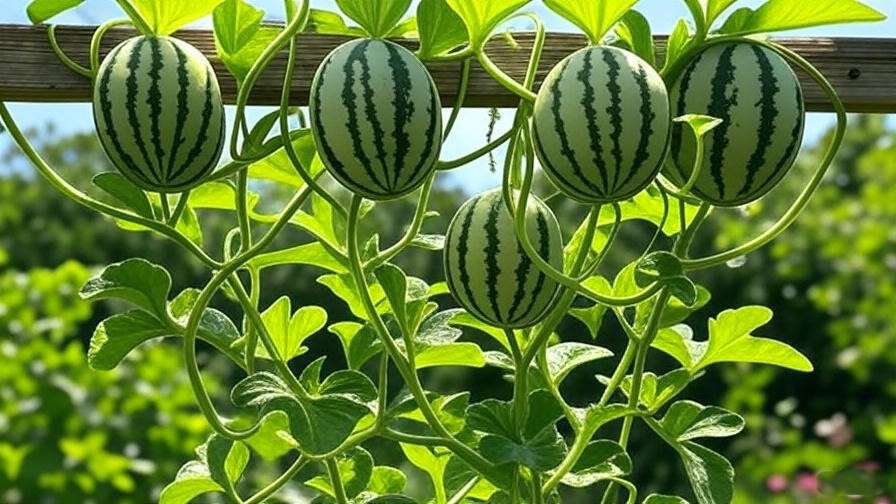
4.3 Fertilizing Throughout the Season
Feed your Congo watermelon plant at key growth stages:
- Early Growth: Apply a nitrogen-rich fertilizer (e.g., 10-10-10) every 2 weeks to promote leafy growth.
- Flowering and Fruiting: Switch to a phosphorus- and potassium-heavy fertilizer (e.g., 5-10-10) to support blooms and fruit development.
- Signs of Deficiency: Yellowing leaves may indicate nitrogen deficiency; poor fruit set may signal low phosphorus. Address with targeted fertilizers.
- Organic Option: Use fish emulsion or compost tea for a natural nutrient boost.
5. Protecting Your Congo Watermelon Plant from Pests and Diseases 🐞
5.1 Common Pests
Congo watermelon plants can attract pests like:
- Aphids: Small, sap-sucking insects that weaken plants. Control with neem oil or insecticidal soap.
- Cucumber Beetles: Striped or spotted beetles that spread disease. Use row covers or hand-pick them early in the morning.
- Spider Mites: Tiny pests causing stippled leaves. Spray with a strong water jet or apply neem oil.
- Organic Strategy: Plant companion crops like marigolds or nasturtiums to deter pests naturally.
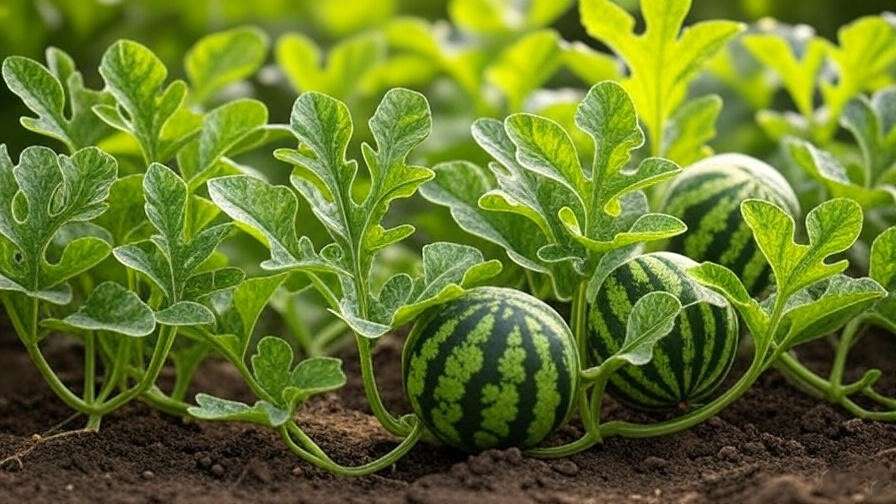
5.2 Common Diseases
Prevent and manage these common diseases:
- Powdery Mildew: White, powdery spots on leaves. Prevent with proper spacing and good air circulation. Treat with organic fungicides like sulfur.
- Fusarium Wilt: Wilting vines despite adequate water. Use resistant varieties and rotate crops every 3–4 years.
- Anthracnose: Dark spots on leaves and fruits. Remove affected parts and apply copper-based fungicides.
- Prevention: Sanitize tools, avoid overhead watering, and remove plant debris to reduce disease risk.
5.3 Weather-Related Challenges
Extreme weather can stress Congo watermelon plants:
- Heat Stress: Use shade cloth during intense heat waves to protect vines.
- Heavy Rains: Ensure good drainage to prevent root rot. Elevate hills in flood-prone areas.
- Case Study: A gardener in Florida saved their crop from mildew by using raised beds and mulching with straw to keep fruits dry.
6. Pollination and Fruit Development 🐝
6.1 Understanding Pollination
Pollination is critical for fruit set. Congo watermelon plants rely on bees and other pollinators:
- Encourage Pollinators: Plant pollinator-friendly flowers like lavender or borage nearby.
- Hand-Pollination: If pollinators are scarce, transfer pollen from male flowers (thin stem) to female flowers (small fruit at base) using a paintbrush.
- Signs of Success: Female flowers will swell into small fruits within days of successful pollination.
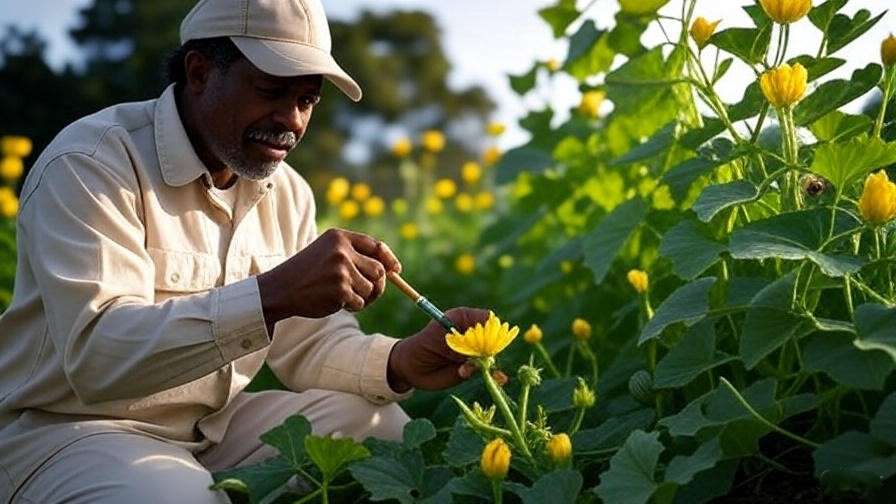
6.2 Supporting Fruit Growth
As fruits develop, take these steps:
- Support Heavy Fruits: Use slings or hammocks to prevent vines from breaking under the weight of large watermelons.
- Monitor Development: Look for a shiny rind transitioning to a dull finish and light green stripes darkening.
- Pro Tip: Place straw, cardboard, or melon cradles under fruits to prevent rot from soil contact.
7. Harvesting and Storing Congo Watermelons 🍉
7.1 When to Harvest
Knowing when to harvest your Congo watermelon ensures peak flavor and texture. Look for these signs of ripeness:
- Yellowing Belly: The spot where the watermelon rests on the ground should turn from white to a creamy yellow.
- Dull Rind: The shiny green rind dulls as the fruit matures.
- Hollow Thump: Tap the watermelon; a ripe one produces a deep, hollow sound, while an unripe one sounds more metallic.
- Timing: Congo watermelons typically ripen 80–90 days from planting, depending on climate and care.
- How to Harvest: Use a sharp knife or pruning shears to cut the fruit from the vine, leaving a 2-inch stem to prevent rot. Avoid twisting or pulling, as this can damage the plant.
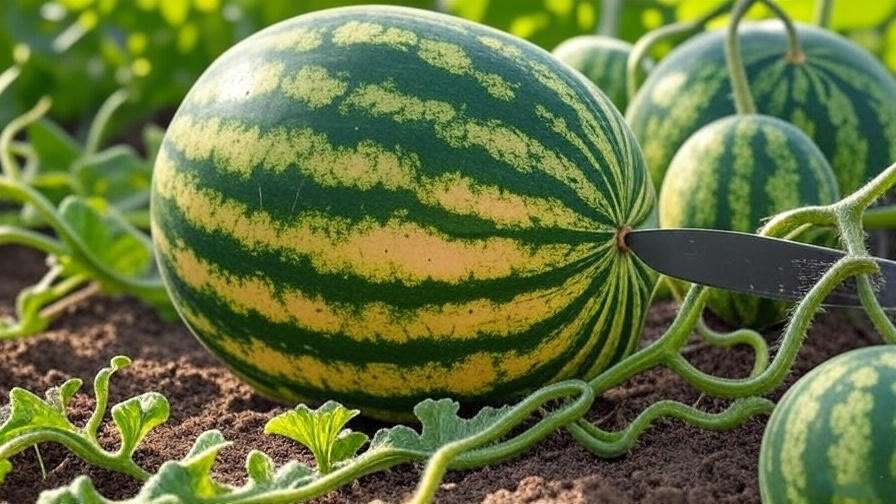
7.2 Storing and Preserving Your Harvest
Proper storage extends the enjoyment of your Congo watermelons:
- Storage Conditions: Store whole watermelons in a cool, dry place (50–60°F) with good ventilation. A basement or pantry works well.
- Shelf Life: Ripe Congo watermelons can last up to 1 month if stored properly.
- Preserving: Cut watermelon can be refrigerated for up to a week. For longer storage, freeze the pulp in cubes for smoothies or blend it into juice.
- Creative Uses: Try watermelon salads with feta and mint, or blend into refreshing sorbets for a summer treat.
- Expert Tip: Label stored watermelons with the harvest date to track freshness.
8. Troubleshooting Common Congo Watermelon Problems 🔍
Even with the best care, issues can arise. Here’s how to address common problems with your Congo watermelon plant:
- Issue: Poor Fruit Set or Small Fruits
- Causes: Insufficient pollination, nutrient deficiencies, or inconsistent watering.
- Solutions: Hand-pollinate flowers, apply a phosphorus-heavy fertilizer (e.g., 5-10-10), and maintain a consistent watering schedule (1–2 inches per week).
- Issue: Vine Wilting or Yellowing
- Causes: Overwatering, fusarium wilt, or pest damage (e.g., root-feeding insects).
- Solutions: Check soil drainage and reduce watering if soggy. Inspect roots for pests and treat with neem oil. For wilt, remove affected plants to prevent spread.
- Issue: Cracked Fruits
- Causes: Sudden changes in water availability, often after heavy rain following drought.
- Solutions: Maintain even soil moisture with mulch and regular watering.
- Expert Advice: Keep a garden journal to log symptoms, treatments, and outcomes. This helps identify patterns and refine your care techniques over time.
9. FAQs About Growing Congo Watermelon Plants ❓
Here are answers to common questions gardeners ask about growing Congo watermelon plants, based on research and practical experience:
- Q1: Can Congo watermelons grow in containers?
- A: Yes, but use large containers (20+ gallons) with well-draining soil. Ensure full sun and support vines with a trellis. Water consistently, as containers dry out faster.
- Q2: How do I know if my watermelon is ripe?
- A: Check for a yellow belly, dull rind, and hollow thump sound. The tendril nearest the fruit should also be brown and dry.
- Q3: What companion plants work best with Congo watermelons?
- A: Marigolds, nasturtiums, and borage deter pests and attract pollinators. Avoid planting near potatoes, which compete for nutrients.
- Q4: How much water does a Congo watermelon plant need?
- A: Provide 1–2 inches of water weekly, adjusting for rainfall. Use drip irrigation to keep leaves dry and prevent fungal issues.
- Q5: Are Congo watermelons resistant to common diseases?
- A: They have moderate resistance to fusarium wilt and anthracnose but require proper care (e.g., crop rotation, good drainage) to stay healthy.
10. Conclusion
Growing a thriving Congo watermelon plant is a rewarding journey that transforms your garden into a source of juicy, homegrown delights. By following this guide—covering soil preparation, planting, watering, pest control, and harvesting—you’re equipped to overcome challenges and achieve abundant harvests. As a horticulturist with over 10 years of experience, I’ve seen firsthand how these expert tips can turn beginners into confident growers. Start your Congo watermelon adventure today, and share your success stories in the comments below! 🌱 For more gardening insights, explore our guides on companion planting or organic pest control. Happy growing! 🍉

